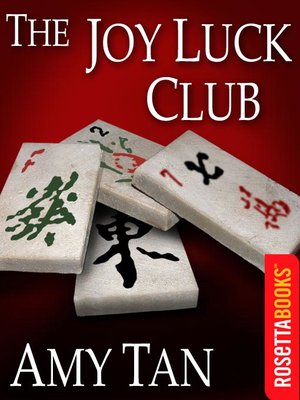

In the novel, Suyuan loses two daughters and does not live long enough to be reunited with them. On the eve of their departure, Daisy revealed that somewhere in China, she had three daughters from an earlier marriage - daughters lost to her when political ties were severed between the U.S. In 1967, Tan, her mother Daisy, and her brother John left California for Switzerland. This central episode in this section of the novel is based on truth. She has two sisters, about whom she knew nothing - until now. Finally, she had to abandon her most precious possessions of all: her two baby daughters. The exodus was so effected suddenly and was so grueling that, along the way, she was forced to abandon all her possessions, one by one.

One day, however, Suyuan tells her daughter an entirely new story: An army officer arrived at their house in Kweilin and urged Suyuan to escape to Chungking as quickly as possible. Because Suyuan's stories about that first Joy Luck Club - especially the endings - change each time she tells them, June discounts them as little more than embroidered, restyled, improvised memories. Each week, four young women met to play mah jong, share a few meager luxuries, and talk about happier times. There, Suyuan created the Joy Luck Club in order to cope with the horrors of war. Her first husband, an officer with the Kuomintang, feared an imminent Japanese invasion, so he took her and their two small babies to Kweilin. In a flashback, we hear Suyuan telling her daughter about the origins of the very first Joy Luck Club, as well as stories from her past. Clairs, and soon she enticed the wives to join with her and form a Joy Luck Club. At the First Chinese Baptist Church, she met the Hsus, the Jongs, and the St. Suyuan innovated this particular version of the club long ago - in 1949, the year she arrived in San Francisco from China. When the novel opens, a mother, Suyuan Woo, has died of a cerebral aneurysm, and her husband has asked their thirty-six-year-old daughter, Jing-mei ("June"), to assume her mother's role and take her seat at the next meeting of the Joy Luck Club. Further, Tan has said that the members of the club represent "different aspects of my mother." How much of the story is real? "All the daughters are fractured bits of me," Tan said in a Cosmopolitan interview. And if I die, what will you remember?"' Tan's answer appears on the book's dedication page, emphasizing the novel's adherence to truth. "Before I wrote The Joy Luck Club," Tan said in an interview, "my mother told me, 'I might die soon.


 0 kommentar(er)
0 kommentar(er)
